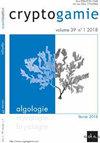When Invaders Go Unnoticed: The Case of Gracilaria vermiculophylla in the British Isles
IF 1.5
4区 生物学
Q3 MARINE & FRESHWATER BIOLOGY
引用次数: 14
Abstract
Abstract Our knowledge of non-native algae in benthic estuarine habitats is relatively poor, especially compared to algal introductions along open shores or on floating structures. Gracilaria vermiculophylla is a widespread macroalgal invader in the temperate estuaries of the Northern Hemisphere, and, here, we expand its documented range within northeastern Ireland and England. Established populations occur within two inlets in the border counties, Carlingford Lough (Counties Louth and Down) and Dundrum Bay (County Down), but G. vermiculophylla is absent from open coasts between these sites. Repeated surveys in Dundrum Bay showed variable abundances, with an increase in biomass between 2013 and 2016. Three populations were discovered in England, where this species had not previously been identified: Christchurch Harbour (Dorset), Brownsea Island in Poole Harbour (Dorset), and Kingsbridge Estuary (Devon). The Irish and English thalli belong to the most common, invasive cox1 haplotype 6. Using a combination of morphological observations and 10 microsatellite loci, we found that the population at Carlingford Lough included both reproductive haploid gametophytes and diploid tetrasporophytes and genetic signatures of sexual reproduction, but the populations at Christchurch and Brownsea displayed signatures of partial clonality. Genetic diversity was higher along the south coast of England as compared to the Irish population, consistent with patterns of diversity previously described for the European coasts. Finally, we also note the occurrence of a putative G. vermiculophylla population in Wales at Porthmadog, Gwynedd. As the sites in which we have now documented G. vermiculophylla in the British Isles also host shellfish aquaculture activities, our study is further evidence for the role of aquaculture in the spread of invasive species.当入侵者不被注意的时候:不列颠群岛上的荆芥的案例
我们对底栖河口生境中非原生藻类的了解相对较少,特别是与开放海岸或漂浮结构上的藻类引入相比。vermiculophylla是北半球温带河口广泛存在的大型藻类入侵者,在这里,我们扩大了其在爱尔兰东北部和英格兰的记录范围。已建立的种群出现在边境县的两个入口,Carlingford Lough (County Louth and Down)和Dundrum Bay (County Down),但在这些地点之间的开放海岸没有G. vermiculophylla。在Dundrum湾的重复调查显示,2013年至2016年间,生物量有所增加,丰度变化。在英格兰发现了三个种群,在那里这个物种以前没有被发现过:克赖斯特彻奇港(多塞特),普尔港的布朗西岛(多塞特)和金斯桥河口(德文郡)。爱尔兰和英国的菌体属于最常见的入侵性cox1单倍型6。结合形态学观察和10个微卫星位点,我们发现Carlingford Lough的种群同时具有生殖单倍体配子体和二倍体四孢子体,并具有有性生殖的遗传特征,而Christchurch和Brownsea的种群则表现出部分克隆的特征。与爱尔兰人口相比,英格兰南海岸的遗传多样性更高,这与之前描述的欧洲海岸的多样性模式一致。最后,我们还注意到在威尔士的波特马多格(Porthmadog, Gwynedd)发现了一个推测的蛭状毛藻种群。由于我们现在在不列颠群岛记录的G. vermiculophylla也有贝类养殖活动,我们的研究进一步证明了水产养殖在入侵物种传播中的作用。
本文章由计算机程序翻译,如有差异,请以英文原文为准。
求助全文
约1分钟内获得全文
求助全文
来源期刊

Cryptogamie Algologie
生物-海洋与淡水生物学
CiteScore
2.60
自引率
7.70%
发文量
11
审稿时长
>12 weeks
期刊介绍:
Cryptogamie is a fast-track and peer-reviewed journal of international scope publishing in English only. It accepts original papers and review articles on the taxonomy, biology and ecology of all cryptogams. An issue of Cryptogamie may be devoted to a single topic, under the responsibility of guest editor(s). All articles published in Cryptogamie are compliant with the different nomenclatural codes. A copyright assignment will be signed by the authors before publication.
Cryptogamie, Algologie accepts articles on systematics as well as ecology and evolution of any kind of algae (including Cyanobacteria).
 求助内容:
求助内容: 应助结果提醒方式:
应助结果提醒方式:


